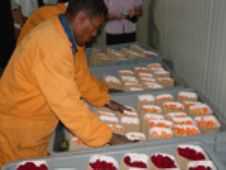Flowers are sign of economic change in Ethiopia
February 13, 2008 (ADDIS ABABA) — Pictures of emaciated children dying in their mothers’ arms during Ethiopia’s famine in 1985 cemented the country’s image as a barren land where nothing grows.
 But just 30 minutes south of the capital, Addis Ababa, green hills and lush valleys abound, perfect for cultivating the country’s fastest growing export — flowers.
But just 30 minutes south of the capital, Addis Ababa, green hills and lush valleys abound, perfect for cultivating the country’s fastest growing export — flowers.
Tsegaye Abebe opened his farm, ET Highland Flora, three years ago. Now, he employs 400 people and exports 90,000 to 120,000 stems every day. At this time of year, he is busy.
“The biggest of all is Valentine’s Day,” he said as workers harvested roses in one of his 23 greenhouses, each one containing around 35,000 stems. In the weeks leading up to Valentine’s Day, Ethiopia exports six planeloads, or more than 2 million stems, daily, he said.
“Red roses are what lovers give so we pay more attention to them at this time of year.”
While flowers account for only 1 percent of Ethiopia’s GDP, they are one of the most visible signs of a fast-growing economy that is becoming less reliant on its traditional coffee exports.
Economic growth was 10 percent last year, the fastest of any non-oil producer in sub-Saharan Africa. Foreign investment, especially from China and India, is on the rise. There is a construction boom in Addis Ababa and many of the larger towns. And returnees from the United States are investing in hotels, bars, shops and restaurants.
Ethiopia exports more than 80 million stems a month to 40 countries. Seventy percent go to the Netherlands, from where they are sent around the world. It also exports to Germany, Britain, Russia and, in smaller amounts, to the United States and the Middle East.
Five years ago, Ethiopia made just $159,000 from exports of cut flowers, cuttings and summer flowers. Last year that had grown to $63.5 million and this year it is expected to hit $166 million, said Adhanom Negasi, an adviser to the Minister of Trade. “Within two years I believe we’ll be the leading exporter in Africa, if not the world,” he said.
Neighbouring Kenya, with 1,700 hectares under cultivation compared with Ethiopia’s 1,000 hectares, has been Africa’s leading flower exporter for more than 30 years. The violence raging there since its disputed election in December has given a 5 percent spike to Ethiopia’s business, Tsegaye said.
“But we really don’t want the problem to continue,” he said. “In business when you get an advantage it should be fair and should come from the strength of your product.”
By next year, flowers could account for 10 percent of Ethiopia’s exports. Coffee, its traditional cash crop, makes up nearly 40 percent.
“I think flowers will catch up to coffee within five years,” says Tsegaye who is president of the Ethiopian Horticulture Producers and Exporters Association. “We expect to generate $600 to $700 million by 2013/2014. Both crops can be successful together.”
The government offers incentives to both foreign and Ethiopian investors, including a five-year tax holiday, duty-free import of capital goods and a lease price of just $18 a hectare per year for land. The government also offers loans of up to 70 percent of start-up costs.
In ET Highland’s packing house, Ethiopian pop music booms from speakers above the factory floor as women strip leaves and thorns from stems, packing them carefully into bunches of 10 and boxing them up for trucks bound for the airport.
Nationally, the industry employs over 50,000 people, 80 percent of them women. “There are so many women because a flower is a very fragile product and it needs very careful handling,” Adhanom said by way of explanation.
Despite complaints from some charities that the workers are underpaid, their pay of around $1 a day is a living wage in a country where more than 80 percent of the population lives on less than $2 a day. Unemployment in urban areas is almost 21 percent.
Many Ethiopians not directly involved with flowers are also benefiting.
In Sebeta, the town that surrounds Tsegaye’s farm, the nearby greenhouses have brought a mini boom of workers and visitors who come to shop and eat. A visit by a foreigner to a local cafe elicits a gift of a red rose from the waiter. “Have you visited the farms?” he asks.
In Addis Ababa, which coincidentally means “New Flower” in the Amharic language, flower shops are springing up and some Ethiopians are even starting to celebrate Valentine’s Day, something they didn’t do just a few years ago.
Hareg Tameru, a painter, opened Flower Boutique two months ago after seeing queues forming to buy Valentine’s roses last year. “I was surprised,” she says. “This business is growing really fast.”
Surrounded by oversized posters of rose varieties, Adhanom shows off spreadsheets highlighting the economic success of the flower industry.
“It’s a miracle.” He throws out his hands and starts to laugh. “This crop is a miracle.”
(Reuters)
